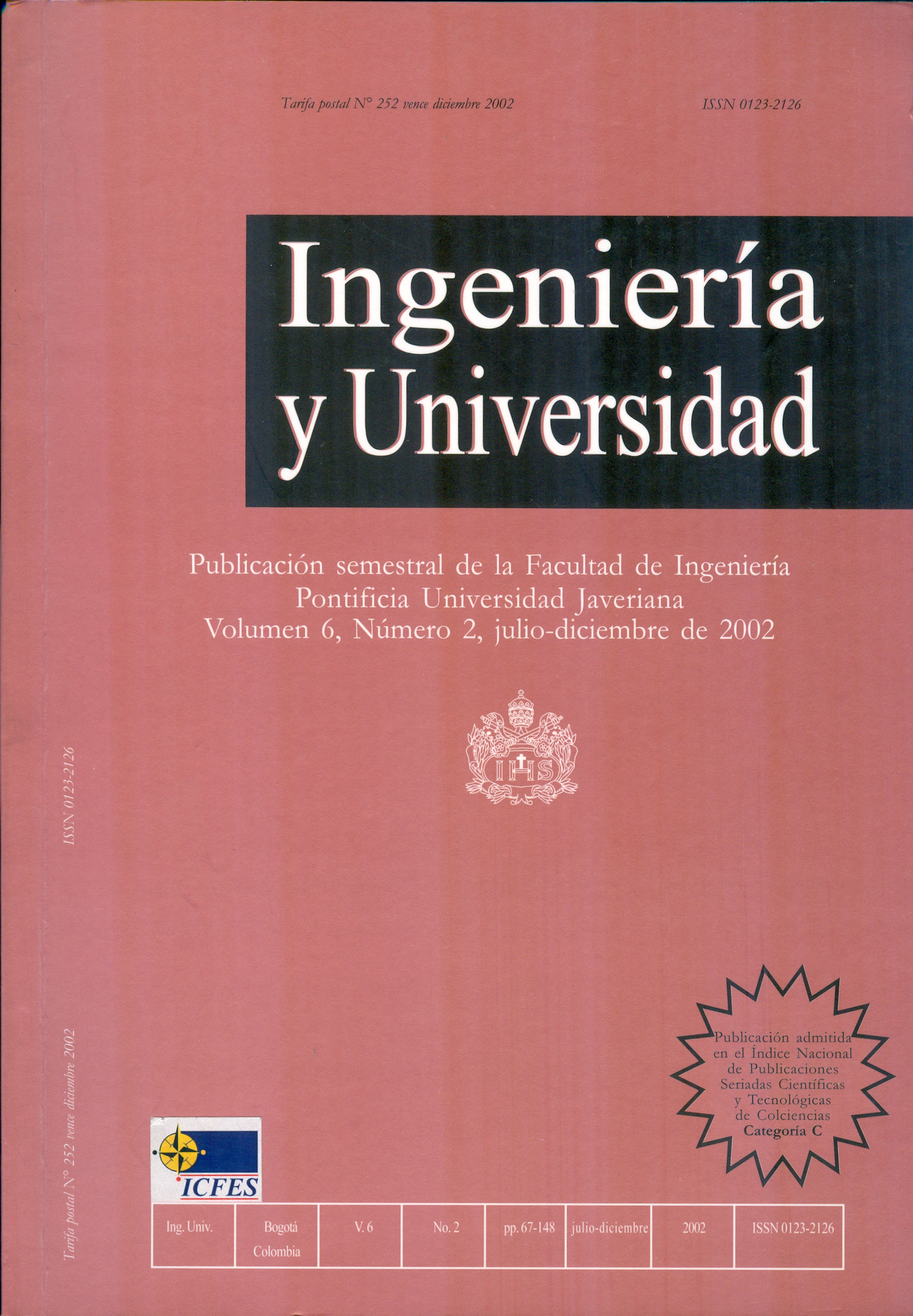Abstract
This work presents a new model to predict complex time series. It ts based on two concepts coming Irotn both Chaos Theory and Artificial Intelligence. Speciiicelly, it uses both the phase space representation of observables and Artificial Neural Network (ANN) for prcdtcting the resulting variables in such space. For the case when a chaotic dynamics behevior is identifled vía nonlinear time series analysis, the problem reduces to train the ANN. Although it is not required to identify such a bebevior in order to apply the model, it is highly suiteble given the obtained results in this work. In this light, it is noted that for an observable that does not come from a dynamical system sbowing low-dimensional chaos, the results suggest a poor efIlciency in the prediction application. In general, the model implies an optimization problem, since in order to achieve an adequate phase space representation it is necessary to es tima te the embedding dimension (mJand the time delay it). Such parameters elongwttb other two related to the topology ofANN forrn a tetradimensional search space which for this case was explored in an exhaustive way.
ABARBANEL, H. D. I., M. B. K. KENNEL, (1992), Local False nearest Neíghbors and Dynamical Dimensions from Observed Chaotic Data, en Phys. Rev. E, No. 47, pp. 3057-3067.
ABARBANEL, H. D. I., R. BROWN, J. J. SIDOROWICH, and L. S. TSIMRING (1993), The Analysis of Observed Chaotic Data in Physical Systems, en: Rev. ofModem Phys., No. 65, pp. 1331.
ABARBANEL, H.D. I. (1988), Analysis ofObserved Chaotic Data, NewYork, Springer.
BOWDEN, G., G. DANDY, and R. MAIER (2002), Ant Colony Optimization of a general Regressíon Neural Network for Forecasting Water Quality. Proceedíngs of the Fífth Intemational Conference on Hydroinformatics, Cardiff, UK, julio 5-8.
CARPENTER, G. and S. GROSSBERG (1988), The ART of Adaptive Pattem Recognítíon by a Self-Organizing Neural Network, en Computer, No. 21(3), pp. 77-88.
CASDAGLI, M., S. EUBANK, J. D. FARMER, and J. GIBSON (1991), State Space Reconstruction in the Presence of Noíse, en: Physica D, No. 51, pp. 52-98.
DELGADO, A. (1998), Inteligencia artificial y minirobots. Bogotá, Ecoe.
DUAN, Q., V. GUPTA, and S. SOROOSIAN (1993), Shuffled Complex Evolution Approach for Effective and Efficient Global Optímízatíon, en: Joumal of Optimization Theory and Applications, No. 76(3), pp. 1015-103l.
FRASER, A. M. and H. L. SWINNEY (1986), Independent coordinates for strange attractors from mutual information, en Physical Review A,No.33,pp.1134-1140.
GRAF, K. E., and T. ELBERT (1990), Dimensional Analysis of the Waking EEG, enE. Basar, (ed.) Chaosin brainfunction, Berlín, Sprínger.
GRASSBERGER, P. and I. PROCACCIA (1983), Measuring the Strangeness of Strange Attractors, en: Physica D, No. 9 pp. 189-208.
GRASSBERGEPR.,, T. SCHREIBERan, d C. SCHAFFRAT(1H991), Non-Linear Time Sequence Analysis, Physics Dept., University of Wuppertal.
HAYKIN, S. (1994), Neural Network -A comprehensive Foundation. London, Macmillan.
HOLZFUSS, J. and G. MAYER-KRESS (1986), AnApproach to Error-Estímatíon in the Application of Dimensions Algoríthms, en G. Mayer-Kress (ed.), Dimensions and Entropies in chaotic Systems, Berlin: Springer, pp. 114-147.
KOHONEN, T. (1984), Self-Organizing and Associative Memory. Springer Series in Information Scíences, Vol. 8, New York, Sprínger.
KOSKO, B. (1992), Neural Networks and Fuzzy Systems: A Dynamical System Approach to Machine Intellígence. New Jersey, Prentíce Hall.
OBREGÓN, N. (2001), Perspectivas en hidroinformática urbana. Seminario Internacional de Hídrología Urbana. Pontificia Universidad Javeriana, Bogotá, septiembre.
OBREGÓN, N., P. AVELLANEDA y P. RENGIFO (2002), Aplicación de las redes neuronales artificiales para la predicción de caudales medios mensuales. Aprobado y por aparecer en las Memorias del XV Seminario Nacional de Hídrología e Hidráulica, Medellín, agosto 29-31.
PACKARD, N. H., J. P. CRUTCHFIELD, J. D. FARMER, and R. S. SHAW (1980), Geometry from a Time Series, en: Physical Review Letters, No. 45, pp. 712-716.
PETTIS, K. W., T. A., BALEY, A. K. JAIN, and R. C. DUBES (1979), An intrinsic dimensionality Estimator from Near-Neíghbor Information, en: IEEE Transactions on Pattem Analysis and Machine Intelligence, PAMI-1(1), pp. 25-37.
PRESS, W., B., F'LANNERSY. ,TEUKOLSKY, and W. VETIERLING (1987), Numerical Recipes, New York, Cambrídge University Press.
PROVENZALE, A., A. R. OSBORNE, and R. SOJ (1991), Convergence of the K2 Entropy for Random Noises with Power Law Spectra, en: Pbystce D, No. 47, pp. 361-372.
PUENTE, C. E. and N. A. OBREGÓN (1996), Determíntstic Geometric Representation of Temporal Rainfall. Results for a Storm in Boston, en: Water Resources Research, No. 32(9), pp. 2825-2839.
RODRÍGUEZ-ITURBE, I. and B. FEBRES DE POWER(1989), Chaos in Raínfall, en: Water ResourcesResearch, Vol. 25, No. 7, pp. 1667-1675, July.
ROWLANDS, G., and J. C. SPROTT (1992), Extraction of dynamical Equations from chaotic Data, en: Physica D, No. 58, pp. 251-259.
RUELLE, D. (1994), Where Can One Hope to Profitably Apply the Ideas of Chaos?, en: Pbysics Today, pp. 24-30.
RUMELHART, D., G. HINTON, and R. WILLIAM (S1986), Learning Internal Representation by Error Propagation, en: D. Rumelhart, J. McClelland, and the ODP Research Group (eds.I, Parallel Distributed Processing: Explorations in the Microstructure of Cognition, Vol. 1, Cambrídge, MITPress, pp. 318-362.
SALZMAN, B. (1962), Fíníte Amplitude free Convection as an ínítíal Value Problern-I, en: J. Atmos. Sci. No. 29, pp. 329-334l.
SÁNCHEZ, L., V., J. ARROYO, K. GARCÍAY, J. REVILLA (1998), Use of Neural Networks in Desígn of Coastal Sewage Systems, en: Joumal of Hydreuhc Engineertng. May, pp. 457-464.
SINCAK, P. M. M. BUNDZEL, D. SOKAC, M. SZTRUHÁR y J. MARSALEK (1998), Urban Runoff Prediction by Neural Networks. Hydroinformatics' 98 International Conference, Rotterdam, Balkema.
TAKENS, F. (1981), Dynamical Systems and Turbulenc, D. Rand, and L. S. Young, en: D. Rand, and L. S. Young, Dynamical Systems and Turbulence, Berlin, Springer, p. 366.
TSONIS, A. A., ELSNER, J. B. (1988), The Weather Attractor over very short Timescales, en: Nature, 333, pp. 545-547.
VASSILIADIS, C. (1990), Neural Networks -Twelve leaming Algoríthms, Twenty Second Symposium on System Theory. IEEE Computo Soco Press, Los Alamitos, Cal, pp. 449-454.
WILCHES, C. (2002), Análisis no-lineal de series de tiempo en ingeniería civil. Proyecto final de grado. Departamento de Ingeniería Civil, Universidad de los Andes, Bogotá.

This work is licensed under a Creative Commons Attribution 4.0 International License.


